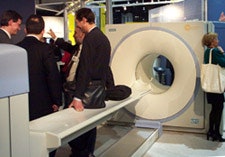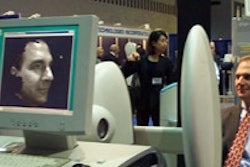CHICAGO - Hybrid imaging with combination PET/CT scanners gained new legitimacy at this week’s RSNA meeting when two of the nuclear medicine market’s largest players introduced new hybrid systems. While their approaches to hybrid imaging differ slightly, GE Medical Systems and Siemens Medical Systems both believe that combined functional/anatomic systems will be the wave of the future.
Imaging vendors have long pursued image-fusion techniques as a means of combining the morphological information of nuclear medicine with the anatomic detail of CT. Up until recently, hybrid imaging was conducted on separate scanners, with the images fused via software techniques.
But software fusion poses problems, such as proper image registration and the cumbersome nature of requiring patients to undergo separate scans. As a solution, several vendors have developed new products that physically combine a CT scanner and a PET camera into a single gantry.
Siemens has been discussing its efforts in hybrid imaging for the past several years, with early work on the technology conducted at the University of Pittsburgh. At this week’s RSNA meeting, the vendor announced that it intends to commercialize a hybrid system, called Biograph, based on that work.
Biograph employs the company’s premium HR Plus PET camera, which has been married with a Somatom Emotion spiral CT scanner. Siemens decided to use systems already in its product line as the components for Biograph due to its belief that clinicians want a system capable of producing fully diagnostic images in both modalities.
Siemens made several enhancements to the combined system due to the rigors involved in hybrid imaging, according to Barbara Franciose, head of the company’s nuclear medicine group in Hoffman Estates, IL. For example, Biograph’s patient bed is mounted on rails, in order to ensure that the bed has the correct deflection as it travels through the system’s bore, which is much longer than a conventional CT or PET scanner.

Siemens received 510(k) clearance for Biograph on October 31, and the vendor plans to begin selling the system in the summer of 2001. Biograph will probably carry a list price of between $2.2 million and $2.5 million, depending on options, according to Franciose.
Siemens is optimistic about the potential of the system to change patient management, based on its experience at the University of Pittsburgh, where some 200 patients were imaged. "In 30% of the cases at the University of Pittsburgh, it actually altered the outcome. They changed their prognosis or their therapy based on the combination of the PET and the CT," Franciose said.
GE has kept its work in hybrid imaging under wraps, with this week’s announcement being the first indication that the company was developing a high-end hybrid product. GE already has two less expensive hybrid systems in its product portfolio: The Hawkeye gamma camera upgrade, and the Positrace hybrid PET/CT system the company acquired from its purchase of SMV this month.
GE’s new hybrid scanner takes functional/anatomic imaging to a new level. The system, which does not yet have a product name, combines a multislice LightSpeed CT scanner with an Advance NX/i PET camera, according to Beth Klein, global general manager of GE’s nuclear medicine and PET unit.
The hybrid system has a much higher throughput than a standard PET camera, Klein said: A PET scan can be conducted in less than 30 minutes. Like Siemens, the company is finding that hybrid imaging can have a definite impact on patient management, with clinicians changing their decisions in 20%-25% of cases based on data from the system.
GE has also added several unique features to the unit. The system can be operated independently for CT or PET studies without image fusion, and LightSpeed scanners in the field can be upgraded to a hybrid system. GE is awaiting clearance for the unit, and expects to begin shipments in mid-2001 at a price of around $2.2 million.
Klein believes that hybrid technology will ultimately become the standard in PET imaging, with clinicians demanding the additional data provided by CT. "In two to three years, people won’t buy PET systems without the CT," she predicted.
By Brian Casey
AuntMinnie.com staff writer
November 28, 2000
Copyright © 2000 AuntMinnie.com
Click here to view the rest of AuntMinnie’s coverage of the 2000 RSNA conference.
Click here to post your comments about this story.



















